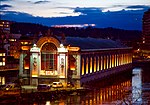International Federation of Freight Forwarders Associations
1920s establishments in AustriaCanton of GenevaFreight forwarders associationsInternational business organizationsInternational organisations based in Switzerland ... and 3 more
International transport organizationsOrganizations established in 1926Use British English from July 2020
The FIATA International Federation of Freight Forwarders Associations is a non-governmental organisation representing freight forwarders worldwide. According to the FIATA Annual Report 2021, FIATA counted 109 Associations Members representing the freight forwarding industry within a territory and 5959 Individual members, representing freight forwarding and logistics companies.
Excerpt from the Wikipedia article International Federation of Freight Forwarders Associations (License: CC BY-SA 3.0, Authors).International Federation of Freight Forwarders Associations
Rue de Coutance, Geneva Grottes et Saint-Gervais
Geographical coordinates (GPS) Address Phone number Website Nearby Places Show on map
Geographical coordinates (GPS)
| Latitude | Longitude |
|---|---|
| N 46.2067289 ° | E 6.1424997 ° |
Address
Manor
Rue de Coutance 6
1201 Geneva, Grottes et Saint-Gervais
Geneva, Switzerland
Open on Google Maps









